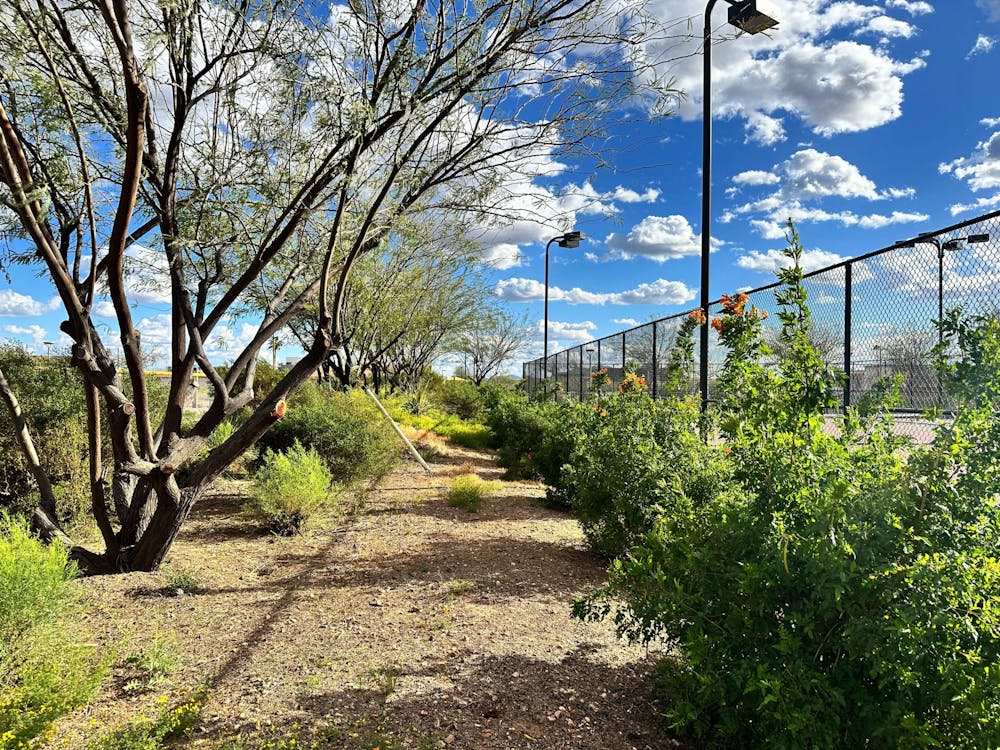Long-term carbon sequestration research at the ASU Polytechnic campus gives students a low entry barrier for real-world research and ways to beautify their campus.
Carbon sequestration is the process of capturing carbon from the atmosphere and storing it in the soil. It could reduce the amount of carbon in the atmosphere to mitigate the effects of climate change.
On the ASU Polytechnic campus, students in a Biology 182 class have the opportunity to collect data as part of a 10-year study on carbon sequestration in arid environments. Cynthia Sagers, a professor in the College of Integrative Sciences and Arts, teaches the class and facilitates the semesterly data collection.
"(Arizona has) the potential for long-term storage, but it also requires some water, and that's where the trade-off is," Sagers said. "We'll continue growing housing developments and urban areas rather than coating it with a layer of sod that needs to be watered. Could we replace that sort of landscaping with native species?"
The project has three main goals: to understand the role of desert biodiversity in carbon sequestration, provide guidance for campus landscaping and get students hands-on research experience early in their college careers.
Margaret Huck, now an ASU alumni, devised the project with Sagers and fellow graduate student Jonathan Ries in a vegetable dynamics course.
"Plants deposit carbon into the ground or sequester it through a couple of different processes," Huck said. "But in desert or arid environments, the carbon that's sequestered into the ground tends to stay there for a really long time, so that's good for removing carbon from the atmosphere."
Huck and Ries' proposal started with a project in their vegetable dynamics course to estimate how much carbon could be held on ASU campuses.
"We were surprised by the amount of carbon that one little area on campus could store in the ground and remove from the atmosphere," Huck said. "We wanted to look at ways that we could improve that sequestration via increasing the plant biodiversity."
The project was devised when they submitted the proposal and received $5000 to establish a long-term carbon sequestration study. The study looks at the benefits of biodiversity, which led Huck and Ries to an area of biodiversity on the Polytechnic campus, the arboretum.
"We chose the arboretum on the Polytechnic campus because we've got an area of campus that was beautiful and was well thought out when it was established over a decade ago, but it's kind of fallen into disrepair," Huck said. "A lot of the signage was fading and outdated.”
With grant money from the Sustainability Initiatives Revolving Fund, they began their project in 2023 by ripping out outdated signage, bringing in new plants from community partners, and establishing 16 plots on the arboretum between the Administration building and quads.
"After spending a semester here, I realized that I loved the beauty of the Sonoran Desert," said Sophia Page, a sophomore studying natural resource ecology and one of the project's leads. "When I started this project, I actually changed my major to ecology. I wanted to study the natural relationships of our desert."
Page and the students in Sagers' Biology 182 class have a hand in collecting soil samples and recording hydration and biomass. With the grant money from SIRF, the team purchased a muffle furnace, which students can use to burn off soil organic matter and estimate how much carbon was present in the soil. This will be compared against the biodiversity of each plot to see if the presence of diverse native species increases the amount of carbon held in the soil.
Students will contribute to a more extensive data set through their class and develop research questions for individual research projects. Page even presented a poster at an American Association for the Advancement of Science conference.
"A couple of students in the first freshman-level class that were involved in the arboretum started looking at those kinds of questions like, 'Do we tend to see more bird species in native vegetation on campus versus grassy lawns?' and 'Do we see more evidence of mammals on the arboretum than other places on campus?'" Sagers said. "We're hoping to make the argument not only for carbon sequestration, which we may or may not pick up in the next 10 years, but thinking about native biodiversity, birds and mammals and butterflies."
Over the entire 10 years, the scope of the project will expand. Even now, there are plans to include new plots to compare against the biodiversity of the arboretum.
"An aspect of the project that we introduced this semester was seeing if there is a difference between carbon sequestration and plots like the arboretum, which are xeriscaped and have more native plants versus grassy plots of lawns," Page said. "The goal of that is seeing if there is more of an (increase) in the native landscape plots and using that data to advocate for grass removal on all of the ASU."
Carbon sequestration is a relevant area of research that aims to reduce the effects of climate change. This long-term research allows students to contribute to the field and even guide campus environment decisions.
Edited by Alysa Horton, Walker Smith and Caera Learmonth.
Reach the reporter at syramir2@asu.edu and follow @nerdyoso on X.
Like The State Press on Facebook and follow @statepress on X.
Sophia is a senior studying biological sciences. This is her fifth semester with The State Press. She has also worked as a science and technology reporter.




